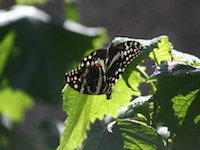Wednesday, April 24, 2024
News and Views from the Global South
KENYA: Farming Butterflies Puts Food on the Table
Ntandoyenkosi Ncube
- For 10 years, Roselyne Shikami, sold boiled eggs at the bus station just outside the densely wooded Kakamega Forest in western Kenya, near the border with Uganda. Now she is selling butterflies.

Farming butterflies is providing forest dwellers sustainable alternatives to cutting down trees for firewood. Credit: Ntandoyenkosi Ncube/IPS
Shikami is one of a small group comprised mainly of women, who have started farming butterflies for sale in Kenya and the rest of Africa. They hope to gain customers in Europe and North America, the two most lucrative butterfly markets. Her husband, Joel, is part of the group. Like many others living around the Kakamega forest, he used to earn his income by cutting trees in the forest to sell as firewood.
According to Kakamega Environmental Education Programme (KEEP), a conservation group that trains women in butterfly farming, Kakamega forest has been reduced from over 240,000 hectares in 1820 to only 23,000 hectares today. The forest is generally considered the eastern-most remnant of the lowland Congolean rainforest of Central Africa. The extensive deforestation has largely been due to population growth and unemployment resulting in land clearance for farming and burning of wood for charcoal for domestic use and for sale.
The government has worked to keep woodcutters and farmers out of the forest and is now encouraging community projects, like butterfly cultivation, as a way of providing alternative incomes.
Kakamega forest has more than 70 percent of Kenya’s butterflies and more than 500 different species. Since its launch in 2001, butterfly farming has turned out to be a money spinner for the communities around the forests, earning farmers the equivalent of over 100,000 US dollars annually says the Kenya Forest Service in its annual report.
KEEP director Benjamin Okalo agrees. “The butterfly business is booming. “A farmer needs only two butterflies to get a thousand pupae and that will be over Ksh 75,000 ($950) in a month – much more money than what one can earn from the chicken or egg selling business.”
Okalo explained that people want to buy as many butterfly species as possible for their collections and to make nice decorations. Butterflies are also bought for research.
“Butterfly specimens here are very beautiful. Big hotels and tourists come to buy them. Rich businessmen are beginning to buy them too for beauty in the house at occasions like weddings and for education for their children,” Okalo says.
Anne Moraah, another butterfly farmer told IPS some designers from Europe use the butterflies to come up with pattern designs.
Farming butterflies
“With this business you don’t need a big farm; you don’t need a big room. Anyone can engage in this business because you only need a small container,” says Roselyne Shikami.
The process involves construction of a small, netted enclosure with food plants for the target species of butterfly. A female butterfly is caught and placed in the breeding cage to lay her eggs on the leaves. The eggs are harvested and tended until they make the transformation from larva to pupa to butterfly – a process that takes about a month.
A farmer must have a license granted by the Kenya Wildlife Services to trade butterfly pupae and other live insects in Kenya and the rest of Africa.
According to KEEP and leaders of another community enterprise, Kipepeo (Swahili for butterfly) projects, another license is required to export butterflies to Europe and North America.
“The big problem is that the wildlife service is reluctant to issue licenses to emerging butterfly business for either domestic or international sales,” says Okala.
At the Second Ministerial Conference on Disaster Risk Reduction held in Kenya earlier this month, Kenya Forestry and Wildlife Ministry chief public communications officer, Mary Ngaruma told IPS that women butterfly farmers should form cooperatives and register their organization before applying for licenses.
“The government is benefiting from them,” said Ngaruma. “The butterfly breeders are looking after our forests and boosting the local economies so there is no reason why we should not grant them trading licenses.”
Environmental benefits
Those involved in butterfly farming stress that while other businesses involving forests tend to be exploitative, butterfly farming is beneficial to the environment.
“When you have a rich number of butterflies it means the environment is good. With fewer butterflies it means there is pollution. Butterflies could also be guides to weather and climate change,” says Joel Shikami.
The International Centre of Insect Physiology and Ecology Senior Research officer, Lamberts Morek, says butterflies are important to the ecosystems because they make their primary contribution to the environment through pollination.
“As scientists our vision is to have a healthy and wealthy environment. It is achievable by empowering these women farming butterflies.”

 Print
Print



